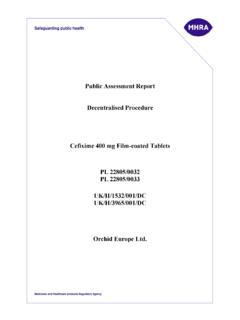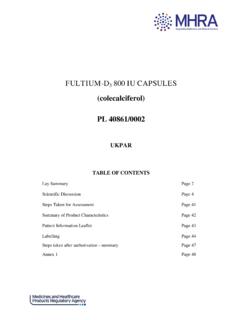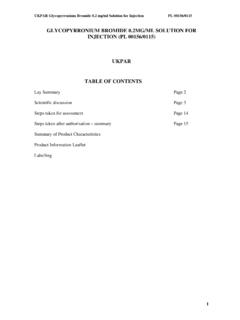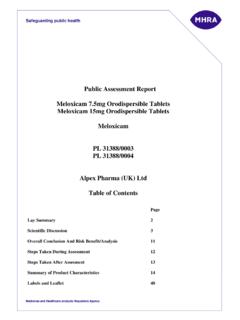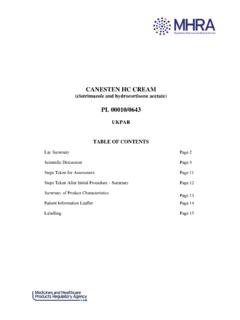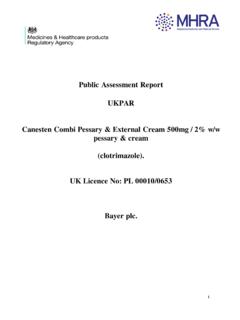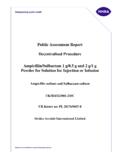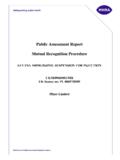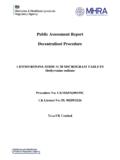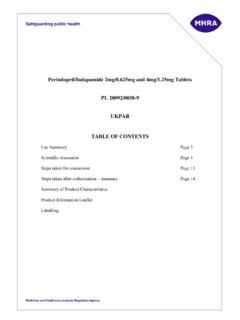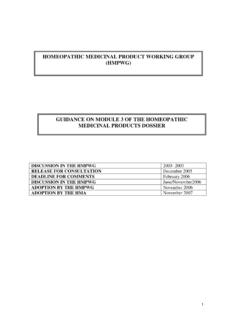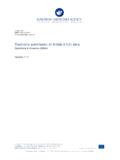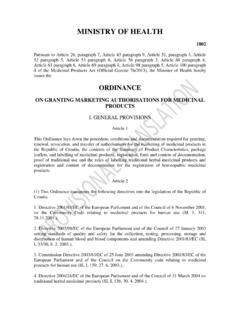Transcription of The Human Medicines Regulations 2012 – …
1 The Human Medicines Regulations 2012 description of each Part This document provides a brief overview of each Part of the Human Medicines Regulations 2012 (SI 2012 /1916). It is intended as a reference material to help users and has no legal effect. Part Description Part 1 General Contains important provisions that apply to much of the rest of the Regulations . These include a description of the role of Ministers and general definitions, including medicinal product and advertisement . There are further definitions in other Parts for terms that are only used in those Parts. Part 2 Administration Allows for the continuing functioning of a number of advisory bodies, including the Commission on Human Medicines and the British Pharmacopoeia Commission. It also provides rules for the appointment and role of expert advisory groups. Part 3 Manufacturing With several associated schedules, sets out the rules for manufacturing, importing and wholesale dealing. It requires that these activities and wholesale dealing be the subject of a licence and establishes what the licensing authority must consider when assessing an application for a licence.
2 It also provides rules around the suspension, revocation, and varying of licences and sets out requirements for Responsible Persons and Qualified Persons. It implements Titles 4 and 7 of Directive 2001/83/EC and includes provisions that were previously in Part 2 of the Medicines Act 1968 and the Medicines for Human Use (Manufacturing, Wholesale Dealing and Miscellaneous Amendments) Regulations 2005 (SI 2005/2789). Part 4 Requirement The requirement that medicinal products be the subject of whichever is appropriate of a marketing authorisation, homeopathic certificate of for authorisation registration, traditional herbal registration or Article 126a authorisation is a central feature of the legal framework and set out in this Part, along with provision for its enforcement. Part 5 UK marketing Contains detailed requirements regarding marketing authorisations. It sets out the material that needs to accompany applications for authorisations authorisations, and makes specific provision for generic medicinal products, biological medicinal products, products with well-established medicinal use, and new combinations of active substances.
3 It also establishes the criteria that are considered in determining whether a product needs to be subject to prescription requirements. The Part imposes certain obligations on authorisation-holders, such as a requirement to take into account scientific and technical progress, and contains rules relating to revocation, variation, suspension, withdrawal of authorisations. Finally, it contains enforcement provision for medicinal products that are subject to the Paediatric Regulation. This Part implements Title 3, Chapter 1 of Directive 2001/83/EC and consolidates material found for the most part in the Medicines for Human Use (Marketing Authorisations Etc.) Regulations 1994 (SI 1994/3144). Part 6 Certification of Describes the homeopathic medicinal products to which it applies and sets out information that must be supplied with an application for a homeopathic medicinal certificate of registration. As with marketing authorisations, it imposes certain obligations on registration holders and sets out rules products regarding revocation, variation, withdrawals, and suspensions.
4 Implements Chapter 2, Title 3 of Directive 2001/83/EC and consolidates the Medicines (Homoeopathic Medicinal Products for Human Use) Regulations 1994 (SI 1994/105). Part 7 Traditional Describes the traditional herbal medicinal products to which it applies Part and sets out the information that must be supplied with an herbal registrations application for a traditional herbal registration. As with marketing authorisations and certificates of registration for homeopathic products, it imposes certain obligations on registration-holders and sets out rules regarding revocation, variation, withdrawals, and suspensions. Implements Chapter 2a, Title 3 of Directive 2001/83/EC and consolidates material currently found in the Medicines (Traditional Herbal Medicinal Products for Human Use) Regulations 2005 (SI 2005/2750). Part 8 126a Implements Article 126a of Directive 2001/83/EC. This article permits Member States, for justified public health reasons, to authorise the authorisations placing on the market of medicinal products authorised in another EEA state in the absence of a UK marketing authorisation.
5 Part 9 Borderline Establishes a process that may be followed when the licensing authority determines provisionally that an unlicensed product is a medicinal products product and therefore subject to regulation as such. It permits persons supplying the product to make written and oral representations to the contrary, and for final determination. These provisions were previously found in the Medicines for Human Use (Marketing Authorisations Etc) Regulations 1994 (SI 1994/3144). Part 10 Exception to Brings together exceptions from certain licensing requirements that are found in several different statutory instruments. These include the requirement for provision for specials that were previously in the Medicines for Human Use (Marketing Authorisations Etc.) Regulations 1994 (SI. marketing authorisation 1994/3144) in accordance with the derogation found in Article 5(1) of Directive 2001/83/EC. These are unlicensed medicinal products that can be supplied providing that certain conditions are met.
6 The Part also makes provision for parallel import licences, and provides an exemption from marketing authorisation requirements for advance therapy medicinal products and the supply of unlicensed Medicines in response to the spread of toxic substances or nuclear radiation. Part 11 Imposes obligations on authorisation holders and the licensing authority in relation to pharmacovigilance (the monitoring of the safety of Pharmacovigilance Medicines in clinical use and taking appropriate action to minimise risk). It implements for the first time in UK law Directive 2010/84/EU, which substantially amends the pharmacovigilance framework in Directive 2001/83/EC. Part 12 Dealings with Brings together many provisions currently previously in Part III of the Medicines Act 1968, the Medicines (Pharmacy and General Sale . medicinal products Exemption) Order 1980 (SI 1980/1924), and the Prescription Only Medicines ( Human Use) Order 1997 (SI 1997/1830), among others. Together, these provisions establish rules relating to the sale supply and administration of medicinal products related to their classification as general sale list, pharmacy, and prescription only.
7 It also creates a number of exemptions from the basic rules for hospitals, certain professionals and supply under patient group directions (PGDs). Part 13 Packaging Implements obligations found in Title 5 of Directive 2001/83/EC by consolidating provisions previously in Part V of the Medicines Act 1968, and leaflets the Medicines for Human Use (Marketing Authorisations Etc) Regulations 1994 (SI 1994/3144), and the Medicines (Child Safety). Regulations 2003 (SI 2003/2317). It sets out the information that must appear on packaging and in leaflets, and contains specific rules for Braille, radionuclides, and homeopathic and herbal medicinal products. Part 14 Advertising Implements Title 8 of Directive 2001/83/EC and consolidates the Medicines (Advertising) Regulations 1994 (SI 1994/1932) and the Medicines (Monitoring of Advertising) Regulations 1994 (SI 1994/1933). It contains a variety of prohibitions on advertising, including those relating to unlicensed Medicines , prescription Medicines , recommendations by scientists, and advertisements aimed at children.
8 In addition, it sets out the information that needs to be included in advertisements and establishes rules for sampling, the promotion of medicinal products by medical sale representatives, and hospitality at meetings. It also contains a chapter called Monitoring of Advertising', which creates a process by which Ministers can determine whether an advertisement breaches these requirements, and in certain circumstances require that corrective action is taken. Finally, it requires Ministers to consider complaints about advertisements and permits Ministers to apply to a court for an injunction prohibiting a particular advertisement. Part 15 British A short part that provides for the publication of the British Pharmacopoeia and related documents. It consolidates several provisions Pharmacopoeia previously in Part 7 of the Medicines Act 1968. Part 16 Enforcement Sets out how the draft consolidated Regulations are to be enforced in England, Wales, Scotland, and Northern Ireland. It also provides inspectors with powers to enter, inspect, and search premises and seize medicinal products.
9 Part 17 Contains a variety of technical provisions, including those relating to prosecutions, defences, decisions made under the Regulations , and Miscellaneous and liability. It also introduces Schedules that contain transitional provisions, consequential amendments, and repeals and revocations. general MHRA, August 2012 .
